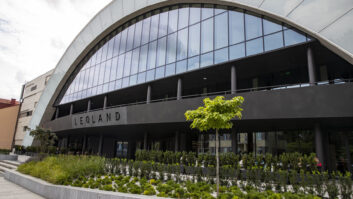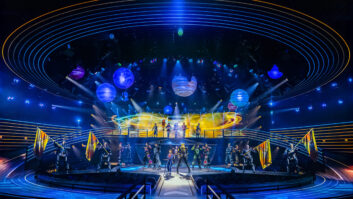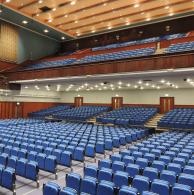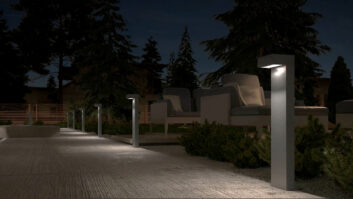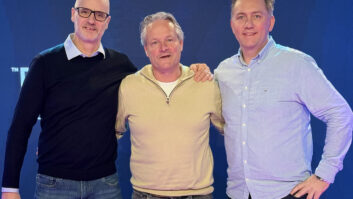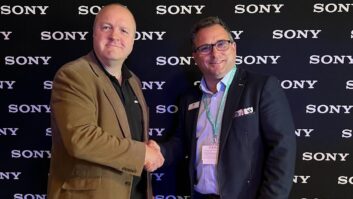General advice states that you shouldn’t believe your own hype. However, even though I’m a lighting practitioner, fully conversant in the ‘tricks of the trade’, I can still be sucked in through a door by good lighting, and then even allow lighting to influence or dictate the very experience I have in that venue!
Take the humble toilet for example. As busy, globetrotting professionals, how many hotel, restaurant and bar toilet visits are clocked up every year across the globe? (I couldn’t even begin to find a statistic for this.) But ask me which toilet I have graced on my travels that springs to mind, and my immediate response is New York’s Bar 89. For those of you who haven’t been there (because, trust me, those of you who have will remember) the toilets at Bar 89 are a visitor attraction in themselves. Prospective users (of both sexes) are greeted by a row of transparent cubicles lit in different colours – it’s not unknown for the uninitiated fainthearted to return cross-legged to their tables. But for those prepared to brazen it out, upon entering the cubicle and closing the door, the glass cross-fades to opaqueness, with the word ‘occupied’ projected on the door. That lighting scheme is infamous for generating physical responses in visitors – panic-inducing for some – and at the very least proves a talking point for others. I specifically selected that restaurant one New Year’s Eve, owing to the reputation of the bathroom lighting, so it’s a great example of the role lighting plays in enticing the customer into a venue.
Concentrating on venue lighting as opposed to commercial sector installations, if we practitioners agree that lighting can make or break a space, do those people with the power to sign off the cheques for venue installations also recognise its imperativeness? Or rather, how is the state of the market?
In a nutshell, all indications suggest it is buoyant to say the least. And while some in the industry are more reserved in their future predictions than others, there is nothing to suggest a slowdown in the market, in any specific venue sector.
Architectural sales manager for lighting control manufacturer Lutron, Anoushka Sulley, confirms this, saying: “The market is strong and, actually, I would say things are on the increase. I can’t predict the future, but right now, we are busier than we were.” At the other end of the control line, luminaire manufacturer Martin Professional’s Morten Gjøtz, vice president – leisure, reports the same. “For the past few years, we have seen increased growth in the venue installation market. And while Western Europe is still taking the lead, Eastern Europe is definitely picking up.”
A geographically connected Europe doesn’t necessarily lend itself to an even economy across the entire territory, and there are some notable highlights, specifically in the east. John Saunders, product manager for Anolis, the architectural arm of ROBE lighting, says: “Central and Eastern Europe are very busy. In areas such as Croatia and Romania, it is the natural development of the countries and their infrastructures that is driving specific growth. We see growth right across Europe, and I would say it has actually increased. If the UK dips we have this surge in Central and Eastern Europe.” And what of the (if the media are to be believed) ailing UK? Cheshire-based i-Pix designs and builds LED fixtures for the architectural and entertainment industries. The company’s Chris Ewington comments: “You hear talk of recession on the news all the time, but none of our customer base, both international and UK, are complaining about depression, if anything far from it.”
This is echoed by Roger Hennigan, technical sales manager for White Light: “Certainly in the UK we are getting more and more enquiries for architectural systems. People are very aware of the importance of venue lighting; any slowdown certainly hasn’t hit us, although a lot of projects will have been costed and funded previously.” “There is no disputing what people are saying on the news, but at the same time I haven’t seen a slowdown yet,” continues Lutron’s Sulley. “I think it depends on what sector of the market you are in, and at Lutron we cross sectors.”
Balancing out
Diversification is then perhaps the key, if it were to transpire that there is indeed a lag time due to hit. But the benefit of hindsight is something that manufacturers and installers don’t afford themselves, and a continued drip-feed reporting of impending recession does nothing to allay concerns. But for those companies that span the globe, it’s perhaps reasonable to expect a downturn in one area to be counterbalanced by the upturn of another region.
So what specific factors are driving the market? Already touched upon is general development in certain countries, primarily within Eastern Europe. But perhaps more important is increased consumer intelligence and hence raised expectations. You cannot fail to notice in everyday life the everincreasing variety of products and gadgets available to the consumer. Even in the local DIY store, a humble rotary dimmer is now outsmarted by dimmers operated with the TV remote control! Consumer savviness increases technological expectations that permeate all aspects of life, including raising the bar in the social environment.
“The brief is much higher these days,” says Sulley. “A client understands that light is such an integral part of design and knows that it is going to make the difference in their luxury hotel or bar.” Wayne Howell, managing director at Artistic Licence, a manufacturer of control, lighting and test equipment, also observes this trend in end-users’ expectations. “People’s personal use of technology has evolved in terms of internet integration – take iPhones for example – and how simply you can download music. People have an expectation that they can buy a box and it will just be able to talk to other things. I think this echoes through into the industry and expectations of connectivity and functionality increase.”
Payback versus status
Peter van der Kolk of Helvar, a manufacturer of ballasts and control electronics for the luminaire industry, identifies other impacting factors. “For commercial buildings, energy legislation is driving the market, however for architectural design it’s really about ambience; it’s quite intangible,” he says. “When the focus is on energy saving and cost of ownership, there needs to be a payback period of typically two or three years. Architectural projects, however, are about creating atmosphere and are often not directly linked with payback periods but rather the status of the building itself.”
With the market driving forward in terms of technology and level of business, LEDs continue to dominate. The very nature of their size lends LEDs to installation in previously unchartered territories within a building, making them a ‘must-have’ for designers seeking to secrete light sources into ceiling coves, wall recesses and the like. Equally beneficial, the eff iciency and potential energy saving of LED fixtures almost needs no introduction, as professionals and the general public become increasingly educated. But, to date, not every aspect of LED technology has advanced as much as some would have hoped, and it is still some way off meeting all the demands placed upon it by practitioners looking for viable alternatives to traditional lighting.
“There are still a lot of issues with LED and until they are solved, I think we are awaiting the ‘real breakthrough’,” says van der Kolk. “Thermal management of products is one challenge, and colour rendering. LED is a very interesting light source, but replacing general lighting with LED will still take a bit of time. “It’s difficult to say how long, if someone solves the issues tomorrow it could be in the next two years perhaps, but otherwise I think it will take another five to 10 years before it replaces traditional lighting. And there are political issues. Traditional lamp suppliers are not going to jeopardise their factories for normal lamp production so there will be some strategic planning behind the introduction as well.”
So what is the take on progress from one such LED manufacturer? Erik Milz, director of strategic marketing for indoor lighting at Philips Lumileds, is unreserved in his excitement for pending and current technology. “In the past couple of years the technology has reached the point where the performance and efficiency levels make sense for general lighting applications; we are really on the cusp!
“Solid-state lighting is going to be on the increase for quite some time; I think we are just at the ramp-up period right now. We are seeing a lot of pilot programmes, large hotel chains, for example, that are implementing solid-state lighting in one hotel, and evaluating it. I think when we get to later in 2009- 10, we will see a significant ‘hockey stick effect’, of a broader mass adoption of the technology.”
This phenomenon is also observed by the Anolis team. “We have always been involved in public areas within hotels, such as reception areas, bars and leisure facilities, but there has definitely been a swing in the past 12 months where it is becoming more acceptable for LED technology to be introduced into the guest rooms,” says Sanders. “People are definitely making the effort to find alternative sources, and we are working in three or four hotels where the guest rooms will include LED as general lighting.”
The talent that LEDs have for decorative lighting is a given, but the jury is still hung on the readiness of ‘white’ LED for general lighting in the here and now. And while, arguably, few would disagree that it’s in the albeit unpredictable offing, how designers are responding in this limbo perhaps serves to illustrate their impatience for future technology.
“The most difficult target is the room with a ceiling full of fluorescent tubes,” continues Milz. “We are seeing lighting designers becoming more creative about how they design those types of environment. Creativity is used and we stop flooding the area with light and focus more on task lighting, and LEDs are perfect. Where you have designers that continue to look to flood the area, we are probably still four to five years away from seeing significant options for that type of application.”
It’s important not to limit the armoury at a designer’s disposal, and become blinded by fashion trends. The old ‘horses for courses’ adage still applies. Martin’s Gjøtz agrees: “The advantages of LED are fantastic, but you have to be aware of its limitations. Of course LED is a ‘must do’ part of the installation but combine it with other fixtures; I think that is really key. The most successful venues we are seeing globally are the ones integrating all kinds of technology to give the best possible experience for the customer.”
The crystal ball is (almost) definitive when it comes to the future of LEDs. At some undetermined point in time, LED technology will get brighter and therefore entirely viable for general lighting; the real conundrum is when? And in other areas such as control, Artistic’s Howell raises key points: “Ethernet for control is going to take off in a huge way, and inevitably we are going to see more products that have Ethernet connectors, possibly as well as, or instead of, DMX. The other development will be in ‘convergence’; show control, lighting control, building management, building maintenance, all starting to converge in the sense of systems being able to talk to each other and make intelligent use of functionality. This could include sending the building manager an email that a lamp needs replacing, along with details of its location. Time-saving uses of technology are something we can look forward to in the next couple of years.”
Howell goes on to suggest “significant” changes in customers’ perceptions of the sales process owing to familiarity with internet purchasing, as well as a reduction in tradeshows, as they shift from a product focus to networking – an interesting debate for another time. For those riding troughs instead of peaks, only history will serve as judge, but manufacturers and installers have every reason to feel confident in the outlook for the market, while consumers continue to enjoy raised standards in design and technology.
